Positive Approach to Pediatric Informed Consent
A successful investigative team shares their ideas on improving enrollment in children's research.
Legislation was recently enacted to ensure that new medications and biological products contain adequate pediatric information in the package insert. This resulted in the need for increased pediatric subject enrollment in medication and biological clinical studies. However, concerns were raised about the ability to enroll pediatric patients in sufficient numbers and the willingness of parents to enroll their children in research studies for agents that were available off-label. This specific concern was raised during a retrospective review of 15 months of screening data from U.S. investigative sites in the RESOLVE trial (Randomized Placebo Controlled Study of the Efficacy and Safety of Drotrecogin Alfa [activated] in Pediatric Severe Sepsis].

As a result of these findings, the RESOLVE study team identified the need for discussion on the informed consent process. The trial's sponsor approached an investigative team that was meeting study enrollment expectations without experiencing parental refusal, and asked them to share their process and discuss with investigators their informed consent practices. As a result of their presentation and discussion, this article will suggest a positive approach to the informed consent process for pediatric trials.
Pediatric legislation
In the last decade, Congress issued legislation that resulted in the need for increased pediatric subject enrollment in medication and biological clinical studies1,2 (see Table 11-6 ). The intent of these legislative acts was to ensure that new medications and biological products contain adequate pediatric dosing information and labeling.
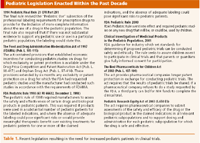
Table 1. Recent legislation resulting in the need for increased pediatric patients in clinical trials.
The Pediatric Rule and subsequent legislation were implemented after an industry incentive approach—the FDA Modernization Act of 1997 (Pub. L. 105-115)—failed to provide a significant increase in pediatric label data. Limited resources to conduct pediatric studies, difficulties with studying the youngest of the pediatric population, and the need for developing expensive pediatric formulations contributed to the failure of the incentive.
A specific concern raised about the Pediatric Rule was the ability to enroll pediatric patients in sufficient numbers and the willingness of parents to enroll their children in research studies.7 In the FDA's estimated costs to industry for the required new pediatric studies, it was noted that an additional 10,860 pediatric patients would be required.7
Informed consent issues
Enrolling pediatric patients is a challenging responsibility for the investigator. An investigator contracts with a sponsor to provide a specified number of patients for the trial. Time and effort is spent on screening and identifying patients based on the protocol's inclusion and exclusion criteria.
The process of obtaining informed consent may have a significant impact on the ability of an investigator to meet sponsor enrollment expectations and, in the long term, may contribute to sufficient patient enrollment to meet the pediatric labeling requirements of the FDA.
Informed consent has been defined as a process by which a subject voluntarily confirms his or her willingness to participate in a trial after having been informed of all aspects of the trial that are relevant to their decision to participate. Informed consent is documented by means of a written, signed, and dated form and an entry in the patient's medical record.8
The responsibility of the investigator with regard to informed consent is outlined in the International Code of Harmonization Good Clinical Practice (GCP) Guidelines and in the Code of Federal Regulations.8 Pediatric patients represent a vulnerable population; therefore, special considerations are needed to protect their rights and to shield them from undue risk. To address the ethical concerns in research on pediatric patients, several organizations have published guidelines.9,10
The Institute of Medicine (IOM) Report on Ethical Conduct of Clinical Research Involving Children reports the need for increased investigator competence in communicating with children and parents about research participation.11 Recommendations from the report on the role of the investigator in the informed consent process are outlined in Table 2.
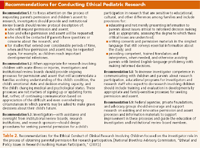
Table 2. Recommendations for the Ethical Conduct of Clinical Research Involving Children focused on the investigator role in the process of obtaining parental permission for research participation. [National Bioethics Advisory Commission, "Ethical and Policy Issues in Research Involving Human Participants," (2001).]
Purpose
As mentioned earlier, this article provides a study specific example of implementation of the positive approach to the initial informed consent discussion. In this case, the approach was limited to parental consent and did not include assent. Enrollment in the RESOLVE study was confined by a strict timeline of when the patient presented symptoms and time to protocol treatment, as well as the patient's protocol-defined severity of illness. It was therefore imperative to primarily obtain consent from the parents, as the children were not in an appropriate state of health to provide consent or assent.
Methods
A retrospective review of screening logs from the U.S. sites for the RESOLVE trial was conducted. The monthly screening logs listed patients that met all inclusion criteria and captured the first exclusion criterion met. The exclusion criteria were ranked with the exclusion for parental consent having the lowest rank. Therefore, when parental refusal was selected, it indicated that the child met all of the inclusion criteria and no exclusion criteria but parents chose not to consent to research participation. Factors known to impact parental decision making, such as education, culture, severity of illness, and previous research experience, were not collected.
A review of 15 months of U.S. screening data by the sponsor indicated that of the 473 subjects screened (who met study inclusion criteria), 41 subjects were not enrolled due to their parents' refusal to give consent (34.7%). This rate ranged monthly from a low of no refusals to sign consent from one patient(s) enrolled (0.0%) to a high of four subjects whose parents chose not to participate to one subject(s) enrolled (80.0%). During this same time period, 77 pediatric subjects were enrolled in the study in the United States, and parents of 41 children refused consent. If the parents of these 41 children had given permission, study enrollment would have increased by 53%.12
The Children's Hospital at Saint Francis in Tulsa, Oklahoma, met enrollment expectations in the RESOLVE study without exclusions for parental consent. During a trial update, the pediatric research team at this site presented the following steps as a Positive Approach to the Pediatric Informed Consent Process to the other U.S. RESOLVE investigative teams. Many of the ideas outlined by this research team are supported by the research cited in the IOM Report on Ethical Conduct of Clinical Research Involving Children.
Positive approach to informed consent
Present the research as a priority. It is best if the Principal Investigator is available to meet and talk with the family at the time of consent. This implies to the family that this research is a priority to the physician and therefore is a treatment option that is worthy of serious consideration. If the Principal Investigator is not available, ensure that a Subinvestigator or an attending physician can meet with the family to discuss the research and answer any questions.
Provide a conducive atmosphere.
- Conduct the discussion in a private room or quiet area where the family can focus on the discussion.
- Provide the family with a note pad and pen and encourage them to write down their questions.
- Inform the family that they can underline or make notes on the informed consent document (ICD).13
- Bring multiple copies of the ICD so that all family members can view the consent and make notes on their own copy of the consent.
Use this opportunity to educate the family.
- Begin the discussion with a concise explanation of the disease state (for example, sepsis) as it relates to their child.
- Present the specific signs and symptoms the child currently displays.
- Discuss the likely progression of symptoms.
- Explain the potential adverse events that may occur as a result of the disease process.
- Describe the medical plan of care (or updated plan of care) for this patient regardless of enrollment in research.
Address any apprehension about participating.
- Explain the purpose of research in a clear, concise fashion.
- Openly answer any questions regarding misconceptions of human research.
- Reinforce to the family that the most aggressive medical care available will be given to their child regardless of their participation in this study.
- Explain that this is an additional therapy option, not a replacement for other approved treatments.
Clearly explain the purpose. For example, let them know that this research is to determine that when compared to a placebo (inactive drug) treatment, the use of drotrecogin alfa (activated) may help children with severe sepsis in the following ways:
- reduce the number of the days spent on a ventilator
- reduce the number of days on medications to improve blood pressure
- reduce the number of days on therapies for kidney dysfunction
- reduce the number of days in the Intensive Care Unit
- improve the overall survival rate (decrease the rate of sepsis-related death).
Be informative of the research data to date. Explain the medication's mechanism of action and any potential benefits for the patient, focusing on the positive result that each patient may have. For example:
- Drotrecogin alfa (activated) has recently been approved by the FDA for adults with severe sepsis who have a high risk of death.
- In severe sepsis, abnormal blood clotting may occur and cause problems in vital organs, such as the heart, lungs, kidney, etc.
- Drotrecogin alfa (activated) decreases the ability of the blood to clot.
When presenting quantitative data about risk, provide frequency information (e.g., a 4 in 1000 chance of an event) rather than probability (e.g., a 0.04% chance).14
Offer private family time for evaluation.
- Acknowledge the parent's anxiety associated with making decisions on behalf of one's sick child and the resulting stress on comprehension, reasoning, and decision making.13,15,16
- Allow ample time for the family to review the ICD privately after the consent discussion.
- Ask the family how much time they need to read and understand the consent.
- If the family does not specify a time, tell them you will return in 30 minutes.
- Inform the staff caring for the patient that the family needs time alone to read the consent.
- Return on time to answer any questions they may have.
Resolve any concerns of being a human guinea pig.
- Reinforce that the FDA and the medical profession have established high standards to protect the rights of each patient enrolled in research.
- Inform the family that an independent research committee has reviewed the likely risks and benefits of the trial and has given the study team approval to conduct the trial.17
- Reinforce that the sponsor has been evaluating this medication in adults for several years. This opportunity is now available for children because the safety data of this medication has met acceptable FDA safety standards in adults.
- Research participants are informed about the study benefits and risks.
- Research participants choose if they wish to participate in research.
- Research participants can end their participation in a study at any time, without penalty.
Explain until the family can verbalize a fundamental understanding
- Does the family understand all the words?
- Review terms like sepsis, study medication, placebo, and blood sample.
- Do they understand the use of the medication?
- Explain the IV infusion. Explain the length of time the patient will receive the infusion and exactly how it will be administered.
- Explain exactly how research lab draws will be made to avoid any additional pain to the patient (e.g., arterial line, central venous line, peripherally inserted central venous catheter) or waste of blood.18
- Review the measures that will be in place to ensure that the child's identity will remain confidential.
- Identify someone the family trusts who is knowledgeable about the study and could consult with the family if they so desire (e.g., the child's primary care physician).
Be accessible to the family.
- Allow plenty of time for questions from the family and encourage an in-depth discussion to promote peace of mind and fully informed consent. Query the parents to assess their level of understanding and encourage feedback.
- Explain the daily follow-up that will take place by the research study coordinator and the principal/subinvestigator(s) to reinforce that the patient will be closely monitored if enrolled in the research study.
- Offer continued access to the research study coordinator and principal investigator throughout their stay in the hospital and through day 28 of follow-up, in case the family has any questions at a later date and time.
- Discuss the opportunity to provide continuing consent. Present the informed consent process as ongoing communication that continues as the parent's understanding and emotional response to the child's condition evolves. Inform the family that the initial consent is the beginning, not the end, of the informed consent process.
Additional resources may be helpful to the investigator in this process. Educational pamphlets on the clinical trial process, research in the intensive care unit, and the specific disease process being studied might assist the family in gaining confidence in a decision to participate.19,20
Results
In the months after the presentation on the Positive Approach to Pediatric Informed Consent and subsequent investigator discussions, a review of the U.S. screening data by the sponsor indicated that 761 subjects were screened (who met study inclusion criteria), 88 subjects' parents gave consent, and 37 subjects were not enrolled due to parents' refusal to give consent (29.6%).
Table 3 provides comparative U.S. screening log data on parental refusal in the RESOLVE trial prior to providing education on the Positive Approach to Pediatric Consent, after the education, and cumulative for the entire study period.12
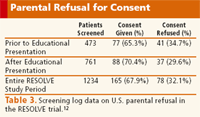
Table 3. Screening log data on U.S. parental refusal in the RESOLVE trial.12
Discussion
Data is lacking as to the expected or possibly appropriate incidence of parental refusal in a randomized, placebo-controlled trial of seriously ill children. This retrospective analysis of the data from the RESOLVE trial is exploratory and intended to foster discussion and future research in the area of obtaining parental permission and appropriate planning for enrollment in pediatric clinical trials.
The 32.1% incidence of refusal observed in the U.S. population of this trial may be appropriate and expected. Table 4 reports research citing the incidence of parent refusal in the RESOLVE trial as compared to other pediatric studies.18,21,22 Available comparative data lacks pediatric intensive care unit patients but does include inpatient anesthesia research and neonatal intensive care unit patients.
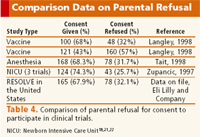
Table 4. Comparison of parental refusal for consent to participate in clinical trials.
Sharing of parental refusal data is important in terms of enrollment targets and timelines for future trial planning. The presentation of this Positive Approach to Pediatric Consent spawned considerable discussion and interaction among trial investigators on their consent practices. Investigators commented that throughout the course of a clinical trial, as additional safety information was reviewed and the experience with the therapeutic agent was gained, they became more "confident" and could speak with more "authority" during the consent process. They also stated that they could better anticipate and address parents' concerns. The investigators expressed this as a potential "learning curve" for each trial, independent of their past research experience.
Positive influence
The "Positive Approach" is an organized, planned, and thoughtful outline of a consent process, where the presentation of the consent form is ethically secondary to the discussion about research participation.23 The "positive" influence is not to be construed as coercive. The approach must be utilized within the framework of additional guidance the IOM Report provides for investigators seeking parental consent of seriously ill children. Particular care should be taken when seeking permission from parents who are just beginning to cope with a child's illness or injury. The investigator needs to be cognizant that the potential for undue influence may exist when the child's physician is also the investigator responsible for seeking consent.
Using the positive approach to informed consent takes a commitment of time and resources by the study team. Data on time spent on the consent discussion was not collected and is a limitation of this retrospective study. For the research team from the Children's Hospital at Saint Francis, there was a considerable time investment with the patient's family, explaining the patient's disease process, the response to treatment, prognosis, medical care options, and details of the research protocol. Within the protocol-defined time constraints, this required a 24-hour on call schedule for the study team.
The team was strongly committed to the process of continuing consent and encouraged parents to continue to ask questions while receiving ongoing information regarding the study protocol, procedures, and plan of care. It was important to the team that the patient and the family felt supported throughout the entirety of the study period. Although this created a positive approach for the families and contributed to successful enrollment at this investigative site, it was an added burden for the research team. There was no alteration in the call schedule to reflect study responsibilities and therefore required an intense commitment through the duration of this project.
The recommendations outlined in Table 2 include the need for ongoing discussion, education, and research in the process of obtaining parental permission to research participation, by both investigators and sponsors of research. The data from the RESOLVE study suggests that by the sponsor sharing data and collaborating with the study investigators on understanding the study specific issue of the parental consent process, the potential exists to address parents' concerns with research participation and improve enrollment rates. However, the evaluation of the RESOLVE data is retrospective and exploratory. Decreasing parental refusals during the conduct of a trial might be a normal pattern based on the "learning curve" discussed by the RESOLVE investigators and might not be related to data provided by the sponsor and education by study investigators. Other variables not captured in the RESOLVE screening log, such as severity of illness and availability of off-label medication, may have influenced the observed change in parental refusal rates.
Conclusions
Medications must be studied in children to obtain safety and efficacy data to provide adequate pediatric information in the package insert. The conduct of research in children carries additional obligations for the investigator. As a vulnerable population, children require additional protection against violation of their individual rights and exposure to undue risk. The primary responsibility for obtaining the informed consent lies with the Principal Investigator.
The guidelines for a Positive Approach to Informed Consent were presented in response to the IOM recommendation that encourages research on existing and innovative permission and assent processes. These guidelines can aid the investigator in obtaining consent in accordance with the International Code of Harmonization Good Clinical Practice Guidelines, the Code of Federal Regulations, and the Guidelines for Ethical Conduct of Studies to Evaluate Drugs in Pediatric Populations.
Only through ongoing education, discussion, and research on informed consent will we have the ability to enroll pediatric patients in sufficient numbers for children to share in the therapeutic advances of medical science.
Kellie E. Brown, RN, BSN, is research coordinator, pediatric critical care, and RogerPhillip Barton, MD, is co-director, division of pediatric critical care, for the Children's Hospital at Saint Francis, Tulsa, OK. Mary A. Short,* RN, MSN, is an associate clinical research scientist and Mary Jane Watson, RN, BSN, is a senior clinical research associate with Lilly Research Laboratories, Eli Lilly and Company, Indianapolis, IN, email:mshort@lilly.com.
*To whom all correspondence should be addressed.
References
1. Pediatric Research Equity Act of 2003, S.650 ES (2003).
2. Department of Health and Human Services, Food and Drug Administration. Specific requirements on content and format of labeling for human prescription drugs: Revision of "pediatric use" subsection in the labeling, final rule, 21 CFR Part 201 (1994).
3. The Best Pharmaceuticals for Children Act. Public L. No. 107-109 (4 January 2002).
4. Clinical Investigation of Medicinal Products in the Pediatric Population (2001).
5. FDA Pediatric Rule 1998, 63 FR 66632 (2 December 1998).
6. The Food and Drug Administration Modernization Act of 1997, Pub. L. 105-115 (21 November 1997).
7. Federal Register, Rules and Regulations, 63 (231), 6631-6672. From the Federal Register Online via GPO Access, wais. access.gpo.gov [DOCID: fr02de98-24] (2 December 1998).
8. ICH Guideline for Good Clinical Practice, Federal Register (9 May 1997).
9. Committee on Drugs, "Guidelines for the Ethical Conduct of Studies 10. to Evaluate Drugs in Pediatric Populations," Pediatrics, 95, 286–294 (1995).
10. Committee on Bioethics, "Informed Consent, Parental Permission, and Assent in Pediatric Practice," Pediatrics, 95, 314–317 (1995).
11. Institute of Medicine, "Ethical Conduct of Clinical Research Involving Children," 2004.
12. Data on file, Eli Lilly and Company, Indianapolis, IN.
13. K. Ruccione, R.F. Kramer, I.K. Moore et al., "Informed Consent for Treatment of Childhood Cancer: Factors Affecting Parents' Decision Making," Journal of Pediatric Oncology Nursing, 8, 112–121 (1991).
14. G. Gigerenzer, "The Psychology of Good Judgment: Frequency Formats and Simple Algorithms," Journal of Medical Decision Making, 16, 273–280 (1996).
15. P. McGrath, "Beginning Treatment for Childhood Acute Lymphoblastic Leukemia: Insights from the Parents' Perspective," Oncology Nursing Forum, 29, 988–996 (2002).
16. R. Levi, R. Marsick, D. Drotar et al., "Diagnosis, Disclosure, and Informed Consent: Learning from Parents of Children with Cancer," Journal of Pediatric Hematology/Oncology, 22, 3–12 (2000).
17. P. Allmark, S. Mason, A.B. Gill et al., "Obtaining Consent for Neonatal Research," Archives of Disease in Childhood, Fetal and Neonatal Edition, 88, F166–F167 (2003).
18. J.M. Langley, S.A. Halperin, E.L. Mills et al., "Parental Willingness to Enter a Child in a Controlled Vaccine Trial," Clinical and Investigative Medicine, 21, 12–16 (1998).
19. Office for Protection from Research Risks, "Tips on Informed Consent," Department of Health and Human Services (2004).
20. American Academy of Pharmaceutical Physicians, "So, You're Considering Participating in a Clinical Trial," (2002).
21. A.R. Tait, T. Voepel-Lewis, M. Siewert et al., "Factors that Influence Parents' Decisions to Consent their Child's Participation in Clinical Anesthesia Research," Anesthesia and Analgesia, 86, 50–53 (1998).
22. J.A.F. Zupanic, P. Gillie, D.L. Streiner et al., "Determinants of Parental Authorization for Involvement of Newborn Infants in Clinical Trials," Pediatrics, 99, 1–6 (1997).
23. National Bioethics Advisory Commission, "Ethical and Policy Issues in Research Involving Human Participants," (2001).
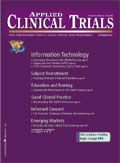
FDA to Launch National Priority Voucher Program to Speed Drug Reviews for Critical Therapies
June 18th 2025Under the new initiative, companies may receive a voucher enabling FDA review to be shortened from the standard 10–12 months to just 1–2 months following final application submission if the drug addresses US national health priorities.
FDA Outlines Updated Requirement for Placebo-Controlled Trials in Vaccine Research
May 21st 2025In an article recently published by The New England Journal of Medicine, FDA higher-ups Vinay Prasad, MD, MPH; and Martin A. Makary, MD, MPH, wrote that any new COVID-19 vaccine must now be evaluated in placebo-controlled studies.
Phase III SELECT-GCA Trial Results Lead to FDA Approval of Rinvoq for Giant Cell Arteritis
April 30th 2025Rinvoq (upadacitinib) becomes the first oral JAK inhibitor approved by the FDA for the treatment of giant cell arteritis in adults, following robust data from the Phase III SELECT-GCA trial demonstrating its efficacy in achieving sustained remission and reducing glucocorticoid exposure.